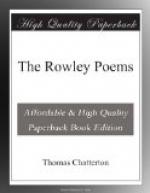1782. Dean Milles’ edition of the Rowley poems—a splendid quarto with a running commentary attempting to vindicate Rowley’s authenticity. Milles was President of the Society of Antiquaries and his commentary is characterized by Professor Skeat as ’perhaps the most surprising trash in the way of notes that was ever penned.
1782. Mathias’ Essay on the Evidence ... relating to the poems called Rowley’s—he is pro-Rowleian and criticizes Tyrwhitt’s appendix.
1782. Thomas Warton’s Enquiry ... into the Poems attributed to Thomas Rowley—Anti-Rowleian.
1782. Tyrwhitt’s Vindication of his Appendix. Tyrwhitt had discovered Chatterton’s use of Bailey’s Dictionary and completely refutes Bryant, Milles, and Mathias. It may be observed in passing that though Goldsmith upheld Rowley, Dr. Johnson, the two Wartons, Steevens, Percy, Dr. Farmer, and Sir H. Croft pronounced unhesitatingly in favour of the poems having been written by Chatterton: while Malone in a mocking anti-Rowleian pamphlet shows that the similes from Homer in the Battle of Hastings and elsewhere have often borrowed their rhymes from Pope!
1798. Miscellanies in Prose and Verse by Edward Gardner (two volumes). At the end of Volume II there is a short account of the Rowley controversy and, what is more important, the statement that Gardner had seen Chatterton antiquate a parchment and had heard him say that a person who had studied antiquities could with the aid of certain books (among them Bailey) ’copy the style of our elder poets so exactly that the most skilful observer should not be able to detect him. “No,” said he, “not Mr. Walpole himself."’ But perhaps this should be taken cum grano.
1803. Southey and Cottle’s edition in three volumes with an account of Chatterton by Dr. Gregory which had previously been published as an independent book. Southey and Cottle’s edition is very compendious so far as matter goes, and contains much that is printed for the first time. Gregory’s life is inaccurate but very pleasantly written.
1837. Dix’s life of Chatterton, with a frontispiece portrait of Chatterton aged 12 which was for a long time believed to be authentic. No genuine portrait of Chatterton is known to be in existence; probably none was ever made. Dix’s life, not a remarkable work in itself, has some interesting appendices; one of which contains a story—extraordinary enough but well supported—that Chatterton’s body, which had received a pauper’s burial in London, was secretly reburied in St. Mary’s churchyard by his uncle the Sexton.
1842. Willcox’s edition printed at Cambridge; on the whole a slovenly piece of work with a villainously written introduction.
1854. George Pryce’s Memorials of Canynges Family; which contains some notes of the coroner’s inquest on Chatterton’s body, which would have been most interesting if authentic, but were in fact forged by one Gutch.




